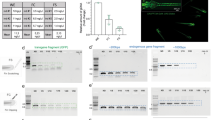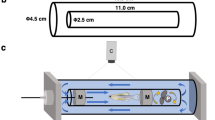Abstract
The zebrafish and the medaka are both important model organisms in biomedical research. Both species are frequently characterized as having a generation time of approximately 2–4 months, but the precise onset of sexual maturity and the variability of reproductive success with age have not been previously examined. The authors studied reproduction in replicate groups of wild-type zebrafish (strain AB) and medakas (strain Cab) that were maintained together in the same aquaculture system. Length, weight and survival of the fish were measured and recorded once per week. Reproductive success and viability of offspring were also evaluated. Both zebrafish and medakas began producing viable embryos within 60 d post-fertilization. These findings show that it is possible to successfully maintain populations of both species within the same research infrastructure without compromising reproductive success or embryo viability.
This is a preview of subscription content, access via your institution
Access options
Subscribe to this journal
We are sorry, but there is no personal subscription option available for your country.
Buy this article
- Purchase on Springer Link
- Instant access to full article PDF
Prices may be subject to local taxes which are calculated during checkout




Similar content being viewed by others
References
Grunwald, D.J. & Eisen, J.S. Headwaters of the zebrafish—emergence of a new model vertebrate. Nat. Rev. Genet. 3, 717–724 (2002).
Wittbrodt, J., Shima, A. & Schartl, M. Medaka—a model organism from the far East. Nat. Rev. Genet. 3, 53–64 (2002).
Shima, A. et al. Fish genomes flying. Symposium on Medaka Genomics. EMBO Rep. 4, 121–125 (2003).
Lieschke, G.J. & Currie, P.D. Animal models of human disease: zebrafish swim into view. Nat. Rev. Genet. 5, 353–367 (2007).
Lawrence, C. Advances in zebrafish husbandry and management. Methods Cell Biol. 104, 429–451 (2011).
Lawrence, C. et al. The challenges of implementing pathogen control strategies for fishes used in biomedical research. Comp. Biochem. Physiol. C Toxicol. Pharmacol. 155, 160–166 (2011).
Best, J., Adatto, I., Cockington, J., James, A. & Lawrence, C. A novel method for rearing first-feeding larval zebrafish: polyculture with Type L saltwater rotifers (Brachionus plicatilis). Zebrafish 7, 289–295 (2010).
Hensley, M.R. & Leung, Y.F. A convenient dry feed for raising zebrafish larvae. Zebrafish 7, 219–231 (2010).
Siccardi, A.J. 3rd et al. Growth and survival of zebrafish (Danio rerio) fed different commercial and laboratory diets. Zebrafish 6, 275–280 (2009).
Jaya-Ram, A., Kuah, M.K., Lim, P.S., Kolkovski, S. & Shu-Chien, A.C. Influence of dietary HUFA levels on reproductive performance, tissue fatty acid profile and desaturase and elongase mRNAs expression in female zebrafish Danio rerio. Aquaculture 277, 275–281 (2008).
Gómez-Requeni, P., Conceição, L.E., Olderbakk Jordal, A.E. & Rønnestad, I. A reference growth curve for nutritional experiments in zebrafish (Danio rerio) and changes in whole body proteome during development. Fish Physiol. Biochem. 36, 1199–1215 (2010).
Castranova, D. et al. The effect of stocking densities on reproductive performance in laboratory zebrafish (Danio rerio). Zebrafish 8, 141–146 (2011).
Adatto, I., Lawrence, C., Thompson, M. & Zon, L.I. A new system for the rapid collection of large numbers of developmentally staged zebrafish embryos. PLoS One 6, e21715 (2011).
Lawrence, C. The husbandry of zebrafish (Danio rerio): A review. Aquaculture 269, 1–20 (2007).
Porazinski, S.R., Wang, H. & Furutani-Seiki, M. Essential techniques for introducing medaka to a zebrafish laboratory—towards the combined use of medaka and zebrafish for further genetic dissection of the function of the vertebrate genome. Methods Mol. Biol. 770, 211–241 (2011).
Trevarrow, B. & Robison, B. Genetic backgrounds, standard lines, and husbandry of zebrafish. in The Zebrafish: Genetics, Genomics and Informatics, 2nd edn. (eds. Detrich, H.W. 3rd, Westerfield, M. & Zon, L.I.) 599–616 (Elsevier Academic, San Diego, 2004).
Furutani-Seiki, M. & Wittbrodt, J. Medaka and zebrafish, an evolutionary twin study. Mech. Dev. 121, 629–637 (2004).
Harper, C. & Lawrence, C. The Laboratory Zebrafish (CRC, Boca Raton, FL, 2010).
Denny, J.S., Spehar, R.L., Mead, K.E. & Yousuff, S.C. Guidelines for Culturing the Japanese Medaka (Oryzias latipes). EPA/600/3-91/064 (Environmental Research Laboratory, ORD, USEPA, Duluth, MN, 1991).
Lawrence, C., Ebersole, J.P. & Kesseli, R.V. Rapid growth and out-crossing promote female development in zebrafish (Danio rerio). Environ. Biol. Fish. 81, 239–246 (2008).
Spence, R., Gerlach, G., Lawrence, C. & Smith, C. The behaviour and ecology of the zebrafish, Danio rerio. Biol. Rev. Camb. Philos. Soc. 83, 13–34.
Kimmel, C.B., Ballard, W.W., Kimmel, S.R., Ullmann, B. & Schilling, T.F. Stages of embryonic development of the zebrafish. Dev. Dyn. 203, 253–310 (1995).
Iwamatsu, T. Stages of normal development in the medaka Oryzias latipes. Mech. Dev. 121, 605–618 (2004).
Monson, C.A. & Sadler, K.C. Inbreeding depression and outbreeding depression are evident in wild-type zebrafish lines. Zebrafish 7, 189–197 (2010).
Kurtzman, M.S., Craig, M.P., Grizzle, B.K. & Hove, J.R. Sexually segregated housing results in improved early larval survival in zebrafish. Lab Anim. 39, 183–189 (2010).
Kamito, A. Early development of the Japanese killifish (Oryzias latipes). J. Coll. Agric. Imp. Univ. Tokyo 10, 21–38 (1928).
Weir, L.K. & Grant, J.W. Courtship rate signals fertility in an externally fertilizing fish. Biol. Lett. 6, 727–731 (2010).
Kang, I.J. et al. The effects of methyltestosterone on the sexual development and reproduction of adult medaka (Oryzias latipes). Aquat. Toxicol. 87, 37–46 (2008).
Kitamura, W. & Kobayashi, M. The effect of water flow on spawning in the medaka, Oryzias latipes. Fish Physiol. Biochem. 28, 429–430 (2003).
Horng, C.Y., Lin, H.C. & Lee, W. A reproductive toxicology study of phenanthrene in medaka (Oryzias latipes). Arch. Environ. Contam. Toxicol. 58, 131–139 (2010).
Uusi-Heikkilä, S., Wolter, C., Meinelt, T. & Arlinghaus, R. Size-dependent reproductive success of wild zebrafish Danio rerio in the laboratory. J. Fish Biol. 77, 552–569 (2010).
Roff, D.A. An allocation model of growth and reproduction in fish. Can. J. Fish. Aquat. Sci. 40, 1395–1404 (1983).
Augustine, S., Gagnaire, B., Floriani, M., Adam-Guillermin, C. & Kooijman, S.A. Developmental energetics of zebrafish, Danio rerio. Comp. Biochem. Physiol. A Mol. Integr. Physiol. 159, 275–283 (2011).
Acknowledgements
We thank Matthew Harris for his critical reading of the manuscript.
Author information
Authors and Affiliations
Corresponding author
Ethics declarations
Competing interests
The authors declare no competing financial interests.
Rights and permissions
About this article
Cite this article
Lawrence, C., Adatto, I., Best, J. et al. Generation time of zebrafish (Danio rerio) and medakas (Oryzias latipes) housed in the same aquaculture facility. Lab Anim 41, 158–165 (2012). https://doi.org/10.1038/laban0612-158
Received:
Accepted:
Issue Date:
DOI: https://doi.org/10.1038/laban0612-158
This article is cited by
-
Zebrafish (Danio rerio) physiological and behavioural responses to insect-based diets: a multidisciplinary approach
Scientific Reports (2020)
-
Genetics and functions of the retinoic acid pathway, with special emphasis on the eye
Human Genomics (2019)
-
A six-months study on Black Soldier Fly (Hermetia illucens) based diets in zebrafish
Scientific Reports (2019)
-
A network of epigenetic regulators guides developmental haematopoiesis in vivo
Nature Cell Biology (2013)



